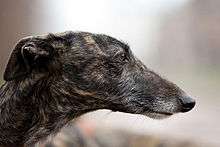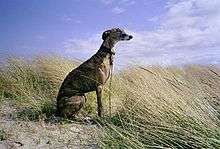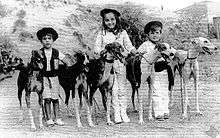Galgo Español
 Two Galgos Españoles | |||||||||||||||||||||||||||||||||
| Other names |
Spanish Galgo Spanish greyhound | ||||||||||||||||||||||||||||||||
|---|---|---|---|---|---|---|---|---|---|---|---|---|---|---|---|---|---|---|---|---|---|---|---|---|---|---|---|---|---|---|---|---|---|
| Common nicknames | Galgo | ||||||||||||||||||||||||||||||||
| Origin | Castile and northern Andalusia (Spain) | ||||||||||||||||||||||||||||||||
| |||||||||||||||||||||||||||||||||
| |||||||||||||||||||||||||||||||||
| Domestic dog (Canis lupus familiaris) | |||||||||||||||||||||||||||||||||
The Galgo Español (Spanish galgo) or Spanish greyhound is an ancient breed of dog, specifically a member of the sighthound family. The English greyhound is possibly a descendant of the Spanish greyhound and, for several years in the 20th century, some breeders did cross-breed Galgos and Greyhounds in order to produce faster and more powerful Galgos, specifically for track racing purposes.
Description

Appearance

Galgos are similar in appearance to Greyhounds, but are distinctly different in their conformation. Galgos are higher in the rear than in the front, and have flatter muscling than a Greyhound, which is characteristic of endurance runners. They also tend to be smaller, lighter in build, have longer tails and have a very long, streamlined head that gives the impression of larger ears. Their chests are not as deep as a Greyhound's and should not reach the point of the elbow [2]
Unlike Greyhounds, Galgos come in two coat types: smooth and rough. The rough coat can provide extra protection from skin injuries while running in the field. They come in a variety of colors and coat patterns. Main colors are "barcino" or "atigrado" (brindle), "negro" (black), "barquillo"(golden), "tostado"(toasted), "canela" (cinnamon), "amarillo"(yellow), "rojo"(red), "blanco" (white), "berrendo" (white with patches) or "pío" (any colour with white muzzle and forehead).
Temperament
Galgos have a very similar nature to Greyhounds. They are calm, quiet, gentle and laid back; happy to sleep their day away on their backs on a sofa. More than 90% of Galgos can be considered cat-friendly and are therefore an ideal choice for the hound lover who also owns cats. Almost all Galgos are also friendly towards other dogs and small dogs. Galgos are also very good with children, being calm in the house so there is less risk of a child being knocked over or jumped on than with a more excitable breed. They are very gentle and tolerate the often over-enthusiastic attentions of children with little risk of retaliation from the dog. Galgos have a very reserved personality and they have a tendency towards shyness, so it is very important that they be socialized early in life so that they grow up to be comfortable around strange people, dogs and locations.[2]
Health

Like many other sighthounds, Galgos are a fairly healthy breed although they are sensitive to anaesthesia. As such, proper care should be taken by the owner to ensure that the attending veterinarian is aware of this issue. Although Galgos are big dogs, their history of selection as a working sighthound, their light weight, and their anatomy keep them safe from hip dysplasia. These dogs must run regularly to keep in perfect health, combined with their characteristic tendency to sleep all the rest of the day.
History
The Galgo is not only "the Spanish greyhound" but also "the Spanish dog". Its name is probably derived from the Latin "Canis Gallicus" or "Dog from Gaul". The Spanish word for all kinds of Greyhounds - including the Galgo - is "lebrel", which means "harrier" or "dog for chasing hares", since "liebre" is Spanish for hare. We can see the same derivative in the Italian "levriero" and the French "lévrier". The first written references to an ancient Celtic sighthound, the "vertragus", in the Cynegeticus of Flavius Arrianus (Arrian), Roman proconsul of Baetica in the second century, may refer to the Galgo, or more likely to its antecedent.
.jpg)
The author Arrian, during his personal experience in Spain, describes hare hunting with Galgos in a manner almost identical to that used nowadays in Spain, adding that it was a general Celtic tradition not related to a social class. He indicates that there were not only smooth haired types of the vertragus but also coated ones.
There is little evidence on the Galgo or its antecedent in the first centuries of the Middle Age but it appeared to survive and flourish in the second half of this period.
In the 9th and 10th centuries great spaces in Castile were colonized, coinciding with the Reconquista, resulting in the Christian military repossession of the Iberian Peninsula from the Muslims. This open land introduces a new character to hunting with dogs: while the North of Spain is mountainous, the regions progressively recovered from the Muslims were flat, open areas full of small animals like hares, which provided the Galgo a useful opportunity to hunt. At this time, it is considered a noble dog, and kept mainly by aristocracy, both in the Christian and the Muslim Kingdoms in which the Spanish territory was still divided at the time. It is likely that the Galgo and Sloughi were interbred at this period.
The great esteem in which the Galgo was held is visible in the many laws of the time designed to punish the killing or theft of this dog: Fuero of Salamanca (9th century); Fuero of Cuenca; Fuero of Zorita de los Canes; Fuero of Molina de Aragón (12th century); Fuero of Usagre (12th century). In the Cartuario of Slonza we can read a will written in Villacantol, in which, using an odd mixture of Latin and Spanish, the Mayor Gutiérrez bequeaths a Galgo to Diego Citid in the year 1081:
- "Urso galgo colore nigro ualente caetum sólidos dae argento";
- "a black Galgo with patches of silver";
The fact that this dog was a significant item in a noble's will, demonstrates the great value that it was given at the time.

The mural paintings at the Hermitage of San Baudelio de Berlanga, in Soria, dating from the 12th century show a hunting scene with three Galgos apparently identical to the ones that we can see today.
In the Renaissance Martínez del Espinar writes in his book "Arte de Ballestería y Montería" ("The Art of Hunting and Archery"):
- "Muchas maneras hay de matar estos animales". (las liebres) "Muchas, diré las que en España usan: correnlas con galgos, que aquí los hay ligerísimos, y así mismo lo son algunas liebres, que se les escapan sin poderlas alcanzar; y no porque corren hoy dejan de volver a sus querencias; antes estas liebres corredoras las continúan, porque tienen conocido el camino de su uida, y por la mayor parte se encaman cerca de alguna senda o camino, orilla de algún soto, monte o ladera, o tierra pedregosa, y así huyen de ellas y de ir cuesta abajo que las alcanzan luego en las laderas y tierra tiesa, parece que vuelan".
- "there is a large variety of ways to kill these animals". (the hares) "Nevertheless, I will tell of those that are used in Spain: they hunt them with Galgos, since here there are some extremely swift ones, although some hares are as swift as them, and sometimes do get away from them. But even having run and got scared today, these hares will come back to their homes tomorrow. They know the way back. They spend the night in some quiet place: a road, a hill, a stony field. In fact they are sometimes surprised in such places by the dogs; then they run away down to the plain, and the dogs try to chase them over the flat ground. They seem to fly".
The Galgo appears to have developed first in the Castillian plains, both in the north (Valladolid, Zamora, Ávila Salamanca, Segovia, Soria, Burgos and Palencia) and the south (Toledo, Cuenca, Guadalajara, Madrid and Ciudad Real) of Castilla. And, afterwards, in more southern territories: La Mancha and Andalusia. It became the typical dog type of the Spanish interior, while the bloodhound plays the same role in the coast regions.

The Galgo appears not only in hunting books but also in common Spanish expressions, as well as in Literature. Maybe the most famous reference is the one contained in the opening sentence of "Don Quixote de La Mancha":
- "En un lugar de la Mancha, de cuyo nombre no quiero acordarme, no ha mucho tiempo que vivía un hidalgo de los de lanza en astillero, adarga antigua, rocín flaco y galgo corredor. "
- "In a village of La Mancha, the name of which I have no desire to call to mind, there lived not long since one of those gentlemen that keep a lance in the lance-rack, an old buckler, a lean hack, and a galgo for coursing."
There are plenty of common expressions in Spain that name the Galgo. For example "A galgo viejo, echadle liebre, no conejo" which means " use old Galgos for chasing hares instead of rabbits" suggests that it is best to use experienced people for hard tasks and challenges. "Galgo que va tras dos liebres, sin ninguna vuelve" meaning "if a Galgo tries to chase two hares, it will return with none" recommends focussing on a single effort, otherwise by distraction, failing.
Although the breed did not apparently experience any significant change in the 18th and 19th centuries, and was kept in its vocation as a swift hunting dog, maybe the most telling proverb which mentions the Galgo, is the one dating from the first years of the nineteenth Century:
- "A los galgos del Rey no se les escapa la liebre";
Meaning
- "The hare never escapes from the King's Galgos";
Which was used at first to satirize the corrupt Government of Fernando VII, considered to cheat in everything it did.
In the first years of the 20th century, large scale crossbreeding occurred between the Galgo and the English Greyhound in order to create faster dogs for professional track racing. This certainly affected the purity of the breed, the resulting dogs were just a bit faster, but did lose their long-distance-running abilities. Finally breeders came to the conclusion that it was not worth crossbreeding. The pure bred Galgo kept its major presence in the Spanish villages as an excellent hunting type.
Despite its antiquity and importance, the Spanish Galgo has only recently been acknowledged by the cynological associations. The English Greyhound has tended to outshine the Galgo. Spain has suffered catastrophic events during the last century, such as the Spanish Civil War and the 40-year-long Francisco Franco fascist dictatorship, which allowed this breed to be kept relatively unknown both inside and outside of its native country, at least until democracy led to greater social and cultural equality and development.
The breed faces the 21st century being progressively more appreciated at home and abroad, as contemporary Spain becomes more conscious of the uniqueness and heritage of this splendid animal.
Roles
Hunting use
The Galgo was used for hunting in monterías and for hunting of hare in open field, where the dog hunt the piece without intervention of the man after a chase. This type of hunting, which now has sporty character, in the past it was an act of social prestige in which hunting was a pretext to prove who was the best specimen holder.
Because of its very particular conditions, Spain is probably the country where the greyhound is used in a greater number of hunting and sports., and is commonly found in any of the towns and cities of the vast geography of the flat Spain. The Galgo of field moves in Spain annually on the order of ten billion pesetas , calculation refers only to a part of fans in the country included in galgueras societies. This small part of galgueros prepared a year between three thousand and four thousand galgos on the occasion of its participation in the various Open Field Championships. This type of events, where each year it rewards the most characteristic example, seem to show that the galguero turns to a breed that was lost years ago.

The crossbreeding with English Greyhound for faster racing has stopped and eradicated for several reasons: On the one hand, this hunting activity is evolving by leaps and bounds to become a real sport, where the killing of hare is secondary for the beauty of the race. The hybrid Galgo loses much of that beauty, what is increasingly valued the purity of the Galgo Español.
On the other hand, the fact that the hare is protected more than ever against the guns and it increasingly stronger by natural selection (has lost its natural places of refuge by rising plowed land and roads of concentration) It makes it necessary hunting with harder Galgos.
In fact, the particular circumstances within geography have an impact, and never a Galgo that leading running generations in Andalusia have the same characteristics as other that leads running so many generations in Castile.
Thus in Andalusia and many parts of La Mancha dominates the vineyard and olive having the hare perdederos next. Similarly being the mild climate, will throughout the year with plenty of food without having to travel long distances. Additionally it less annoying to be within large farms without neighbor roads. All these issues will make the Galgo prevails in these areas is smaller and muscles somewhat shorter and rounded, ie, higher power in the hindquarters. This is because it must be a Galgo that reaches quickly and out of cuts more easily. Lighter by the softness of the ground where step and definitely more rapid and less strong, although a property does not necessarily exclude the other.
In Castile, where large spaces, the hare travels great distances in search of food and its only defense being away its perdederos are its legs and its heart. In this type of land it is to impose other Galgo harder footprint, deeper breast, longer and flatter muscles, ultimately a greyhound higher strength. These greyhounds are heavier have more appeal, and in fact have been considered purer of face to the stabilization of the race.
Also, outside of Spain, in Chile (mainly in the Central Zone), these dogs are used in competitions that take place on national holidays.
Galgos as pets
Due to their primary role as hunting dogs in the Spanish countryside, the Spanish Galgos are sometimes treated a little better than commodities. However, most people know that Galgos are mistreated and abused in their native Spain. Galgueros (breeders), as they are normally called, will often select puppies from a litter that show the most propensity for hunting or racing, while abandoning the rest in the streets. The puppies that do get selected often do not live very long lives, as the galgueros often consider the dog too old to hunt once it has achieved two or three years of age-often after hunting season ends, they are either abandoned, shot, or hanged. For all these reasons, many associations in defense of the Galgo have appeared with the aim to save these dogs from a terrible fate, provide much needed rehabilitation, and adoptive homes, usually in the cities. Some associations will adopt them to other locations in Europe, including France, the UK, Germany, Belgium and the Netherlands.

Because they tend to be quiet and docile, Galgos make very nice house pets. In Spain they have a well earned reputation as gentle dogs, with sweet temperaments and solid health. They tend to get along well with people and other dogs, and they can be well-behaved around cats if properly socialized. Outside of sunny Spain, they require a warm coat to keep them warm in cold winter weather: like all greyhound type breeds, they have little body fat and short coats, so extra warmth is preferred for colder climates.
Galgos excel at performance activities like lure coursing and racing. They are eligible to compete in lure coursing events sanctioned by the American Sighthound Field Association, entered in the Limited class. They also make very nice show dogs and have enjoyed success in the European show ring, although they are not as well known in the American show world due to their rarity outside Europe.
References
External links
- Galgo Rescue International Network
- Love, Hope, Believe, Galgo Adoption Inc.
- The Sighthound Underground
- Galgos del Sol
- Video: How Galgos hunt
| Wikimedia Commons has media related to Galgo Español. |